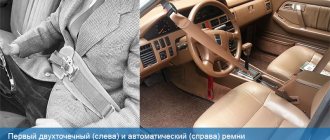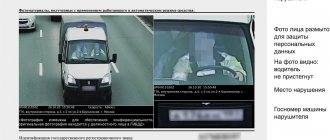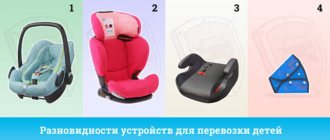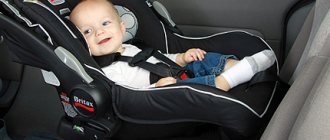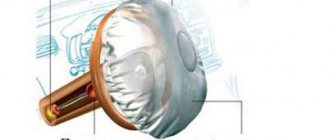When talking about safety measures and protecting passengers from injury in dangerous situations, we often come across information that concerns new-fangled systems for recognizing potential danger and automatically applying critical braking. In addition, trying to increase the safety of passengers and the driver in the car, engineers and designers are trying to strengthen the car body as firmly as possible from deformation and damage. However, many often forget that passive driver protection is one of the main points of safe movement on the road. Seat belts are one of these “forgotten” ways to protect your own health, providing one of the main roles in protecting passengers.
A seat belt is a means of passive protection for the driver and passengers of a vehicle, the main functional significance of which is to hold the passenger in the most static position during emergency braking (due to an accident or simply sudden braking).
The design of almost all seat belts is similar and does not present any particular difficulties in maintenance.
Design features and varieties
Seat belts began to be installed on cars at the dawn of the automotive industry. The first attempts to develop a simple protection device were made at the very beginning of the 20th century, but at that time they did not show decent results, and continuing research in this direction became impractical.
The second round of interest in this type of security mechanism appeared in the last century. The device was offered as an additional option, and not a mandatory element of the entire car design. Only after some time the strap began to be installed as basic equipment.
Automotive researchers have considered replacing belts entirely, and alternatively using only panel-firing airbags. But numerous tests have shown the low effectiveness of using pillows independently, as opposed to using them together.
Now seat belts (SB) have become an integral part of any car, which allow you to keep passengers in the seat, regardless of the emergency situation that has occurred.
The main component of the passive safety device is fibrous polyester tape. This material has characteristics that allow it to withstand high loads and is also less susceptible to mechanical stress and tearing. The strap holds the body in a fixed position, preventing it from moving forward in a frontal collision.
Another important fact is that the RB prevents the possibility of a motorist or passengers inadvertently flying out of the vehicle, and also ensures the impossibility of a collision with the structural elements of the car.
A complete RB design includes:
- fixed and movable safety equipment attachment points;
- lock;
- reels that have an inertial tension function that allows you to move smoothly on the seat;
- limiters;
- pretensioner
The above elements appeared as the automotive industry developed, and even today, not all cars have a passive safety system that combines each of them at the same time.
Instead of the result: to buckle up or not?
According to statistics, the risk of death or serious injury if a person does not wear a seat belt increases by 2.5 times in a frontal collision, 1.8 times in a side impact, and 5 times in a rollover.
The human body, not secured by seat belts, moves uncontrollably around the cabin. This can cause harm to the health of not only the person himself, but also all other passengers. You shouldn't rely on airbags alone. The vehicle's passive protection system is effective only in its entirety, when the airbags are deployed and the passenger's body is securely secured in the seat with seat belts.
Add ProCrossovers to your favorites
Types and distinctive features
The key criterion by which RBs differ is the number of fixation points. This parameter is of fundamental importance and helps to minimize injuries during an accident.
The following types of RB exist:
- point-to-point,
- three-point,
- four-point,
- five-point,
- multipoint.
It is important to note that the number of fixation points often makes the use of a safety belt insufficiently comfortable, but increases the likelihood of injury.
2-point
The two-point seat belt was one of the first to be installed on production vehicles (TS). The effectiveness of this type showed the least results. In total, 2 types of RB such fastening systems are provided.
In the first option, the passenger is fixed in the lumbar region transverse to the seat. One mount was located in the sill or side pillar area, and the other was located between the front seats. For the convenience of fixing the RB, the security system included a lock with a latch.
The disadvantage of the design is that the strap only held the lumbar region, and in an accident the person continued to move the upper part of the body by inertia in the direction of the steering column or panel. Thus, it is simply impossible to avoid injury, although it is possible to keep the body from flying out.
The option with a chest strap provided for the installation of fasteners on the side pillar and between the front seats. In the event of a collision, the RB guaranteed the retention of the body, but the likelihood of the person fastened slipping under the belt increased, which also contributed to the high incidence of injuries.
3-point
Most modern vehicles use three-point seat belts, given that such a system is considered the most practical to use and eliminates the possibility of further movement of the fastened person in a collision due to inertia.
This type of design has three clamps - two points in the side pillar, and 1 with a lock between the seats.
The mounting point on the side of the vehicle pillar is fixed, and the other is equipped with a coil to automatically return the vehicle to its original state. A movable lock tongue is attached to the RB for easy fixation of the seated person. This design combines two types of 2-point seat belt at the same time.
The sliding tongue for the lock allows you to sit comfortably in the seat and, in one motion, secure your body in a stationary state in case of an emergency.
Fine for not wearing a seat belt
Article 12.6 of the “Code of Administrative Offences” states:
“Driving a vehicle by a driver who is not wearing a seat belt, transporting passengers who are not wearing seat belts, if the design of the vehicle provides for seat belts, as well as driving a motorcycle or moped, or transporting passengers on a motorcycle without motorcycle helmets or wearing motorcycle helmets that are not fastened - shall entail the imposition of an administrative fine in the amount of 1,000 rubles."
For many, this is not such a large amount, so we often see both drivers and passengers ignoring this requirement. But the point here is not the size of the fine, but the size of life: it’s easier to buckle up and stay alive with 1,000 rubles in your pocket.
4-point
The four-point mounting system is rarely used on budget or low-performance cars, and is often only seen on racing or sports vehicles.
Due to the inconvenience of use, it is not widely popular. The attachment points in such a device may vary. One of the types includes vertical straps with a fixed one-piece fastening and one detachable one in the lumbar area. A special feature of this system is that the vertical straps are not attached to the structural elements of the body, but directly to the seat.
Before getting into cars, you will first need to put 2 straps over your shoulders, after which you need to stretch and secure the lumbar belt.
The second version of the system provides fixed vertical straps that can be freely detached. Each of them has a tongue for installation in the lock.
Traffic regulations regarding the use of seat belts
Let's look at the provisions of the traffic rules, which talk about the requirements for seat belts in a passenger car and not only:
- 2.1. The driver of a motor vehicle is obliged to:
- 2.1.2. When driving a vehicle equipped with seat belts, be fastened and do not carry passengers who are not secured by them. When driving a motorcycle, you must wear a fastened motorcycle helmet and not carry passengers without a fastened motorcycle helmet.
- 5.1. Passengers are obliged to:
- when traveling in a vehicle equipped with seat belts, be wearing them, and when riding a motorcycle, wear a fastened motorcycle helmet;
It’s simple - the vehicle is equipped with straps, which means you need to comply with the requirements of the traffic rules and buckle up.
Until November 20, 2010, there were several exceptions to the traffic rules: driving instructors, drivers and passengers of operational services could not use seat belts. From 2021, everyone without exception is required to wear a seat belt.
5-point
Five-point seat belts, like the previous type, are widely used in sports vehicles, as well as in car seats for children.
In terms of its structure, it is the same 4-point belt with an additional strap. The auxiliary element is located at the bottom of the seat - between the legs, and is placed in a special lock.
This type of protection guarantees the most reliable retention of the body, and also allows you to distribute the load evenly across the belts.
What can you pay attention to when choosing a belt?
- Components. It should be noted that each car has an individual security system structure, which may differ on different models.
- Fasteners The fundamental element in the passive safety system is the fastener, since it ensures the strength of the structure. Fasteners are mounted on body elements, since at the moment the body moves by inertia with acceleration, a colossal impact is exerted on the belt.
If the fastenings were mounted in the seat, then excessive loads could simply destroy the integrity of the structure, since the backrest moves along with the body.
When installing the mount into the body, such displacement cannot occur. The exception is cases when the impact leads to a total violation of the integrity of the body. The fastening system may provide for fixing the belt directly into the seat. This design is typical in sports cars, where the seats for the driver and passenger initially provide for the impact of enormous loads, for this reason such fasteners are possible. The lumbar belt is attached exclusively to the body.
Types of seat belts
The prototype seat belt device has been around for a long time. It went through its own evolution, which led to the fact that today we have several types of seat belts that have the same basis, but differ in small details and some functions.
We list the types of seat belts :
- Two-point seat belts (lap belts) are the most outdated type of all existing today. However, it is found on both old cars and modern models. This type is mainly suitable for equipping the rear seats of cars. It is located at the waist, usually fastened from right to left. The lap belt is not very comfortable to use, has its drawbacks, and also does not fully guarantee that the passenger is completely protected from adverse influences;
- Three-point seat belts (diagonal lap). This device is very popular among automobile manufacturers. Its main characteristics are: the original V-shaped arrangement, due to which the load is distributed evenly over the entire rim. The three-point belt is universal because it fits all types of seats, both in the front row and in the back;
- Four-point seat belts. Production cars use this device quite rarely. This type of belt is used mainly on special vehicles, sports cars and SUVs. The principle of operation of a four-point belt is indicated by its name - the belt is attached to the seat at four points, which keep the passenger’s body from all kinds of shocks and rollovers;
- Five-point seat belts. The type is a highly specialized passive safety device. They are usually equipped with expensive seats in supercars or child seats. The five-point belt includes: two perpendicular waist belts, which “start” from the person’s shoulder, as well as one additional one - it is located between the legs.
Ease of use
Speaking about ease of use, it should be noted that vertical belts are suitable for a person of any build and height, in contrast to belts with a diagonal attachment point in the body.
A diagonal belt with fastening in the body can pass almost in the neck area of a short driver. This circumstance indicates not only inconvenience, but also unsafe operation, since at the moment of a collision the inertial force and tension of the belt will act on the person’s neck. This results in a high probability of injury and significant harm to health.
For tall people, a diagonal position of the belt with an attachment point in the body is also not always suitable, since the strap passing below the shoulders can significantly restrict the movements of the arms.
Manufacturers of modern cars have taken care of this and have provided the possibility of moving the body mount in height for optimal adjustment to the seated person.
Lock part
The detachable design element of the fastening point provides a convenient location of the seat belt straps.
The principle of operation is simple - a metal tongue with a hole, attached to the belt, is inserted into the lock hole and secured with a pin to fasten the structure. There is a button on the lock body that retracts the pin and separates the elements.
The key to the effective operation of the entire passive safety system is the correctly adjusted RB tension. Previously, each driver or passenger was required to adjust the straps to suit their body size. If the driver had to do this quite rarely, then the passenger must carry out the adjustment constantly.
With the advent of inertial reels in the design, the issue of constant belt length settings was resolved forever. The car seat belt device automatically tensioned the belt so that the passenger or driver could fit comfortably in the seat.
The main feature of the reel is the function of blocking the belt if you try to sharply pull the tape out of the device. The mechanism will not allow you to quickly unwind the coil, preventing the person sitting in the seat from shifting due to inertia when the car suddenly stops.
The inertial coil performs 3 main functions:
- provides the necessary belt tension, adapting to the body composition of the seated person;
- automatically collects the belt after it is unfastened;
- prevents involuntary movement of the body during sudden braking or stopping.
There is also a drawback - the mechanism technically does not have time to instantly respond to sudden tension. This allows the body to speed up a bit in an emergency, which significantly increases the likelihood of injury.
Limiters
The main function of the limiter is an insignificant and smooth increase in the length of the seat belt.
During emergency braking or a collision, the body continues its inertial movement, being subjected to significant overloads. Seat belts that are not equipped with limiters instantly stop the vector of movement, injuring the chest, neck or lumbar region of a person.
A gradual and smooth increase in the length of the belt allows you to reduce the speed of inertial movement, while reducing the likelihood of injury.
The limiter has the form of a torsion bar, which acts as an axis for the coil. When triggered, the reel stops the unwinding of the belt, the body rests against the belt, creating a load on the belt.
What in the end...
It is important to decide for yourself that the use of a seat belt is not a condition of malicious traffic regulations, which are only allowed to burden unfortunate motorists.
First of all, this is our own protection from possible damage that awaits us at every corner. An airbag is not always able to protect us from injury, since the inertial force of an impact can displace the passenger's body away from the deployed airbag. The consequences of significant tugging on the body of a passenger or driver are negligible compared to the damage to an unbelted person. Another common opinion is that some argue that it is not necessary to wear a seat belt while in the back row. Even despite the protective barrier in the form of a seat in front, an unrestrained rear passenger still has a high probability of flying through the windshield or receiving other life-threatening injuries.
Holding a child in your arms in the hope of his safety is also not worth it. Even while at minimum speed during an accident, the risk of letting go of a child is unusually high, as a result of which the child can receive severe injuries.
Pre-tensioner element
Pretensioners began to be installed in seat belt designs several years ago, but their role should not be underestimated. As noted earlier, the reel cannot technically stop the unwinding of the belt instantly, which is why the body still manages to continue its inertial movement. It is to prevent this drawback that pretensioners were developed, tensioning the belt until the moment of a sharp stop and inertial movement of the body.
There are 2 main types of pretensioners.
- Squib cartridges.
- Electrically driven.
Here, the mechanical principle of operation alone is no longer sufficient. Advance tension of the belts is ensured by the activation of additional shock sensors that send a signal to the control unit, which are equipped in modern cars.
General operating principle
It will take literally 1 minute for the driver or passenger to fasten their seat belts.
As an example, let’s consider a mechanism with a three-point fixation system, due to their mass and greatest prevalence. After the driver is seated in the car seat, it is necessary to smoothly pull the belt to the required length, directing the metal tongue into the hole in the lock.
Having heard the characteristic sound of a latch, you can release the belt, allowing the inertial reel to remove the excess length.
If the structure is equipped with pretensioners, then in an emergency it is they who begin their work:
- in the event of a collision, sensors located in the nose of the car will transmit the relevant information to the on-board computer, which activates the pretensioners to tighten the straps;
- As the load increases, the torsion bar comes into play, successively increasing the length of the strap to dampen acceleration.
If the design does not provide for the presence of the element in question, then their task is performed by the coil together with the torsion bar.
How the seat belt works
The seat belt must secure the occupant's body in a permanent place and in a stable position. The body moves while driving, and an unsuccessful maneuver by the driver or any kind of skidding can provoke an accident, which, thanks to the belt, should not affect passengers or affect them to a lesser extent. Therefore, you need to be able to fix the belt correctly and have, in fact, the belt that is more reliable and suitable for you.
Seat belts are made of tensile fiber, which is capable of absorbing additional kinetics that arises (during maneuvering ) due to the counteraction of two bodies. When considering the seat belt system, we must also not forget about the energy-absorbing device, which is presented in the form of shock absorbers and extensions.
Recommendations
No one can ever know when an accident will happen. An analysis of a huge number of videos of road accidents suggests that the survival rate in serious accidents is many times higher for passengers who were using the RB at the time of the accident.
Situations cannot be ruled out when an unbelted driver simply flew out of the vehicle at the moment of the first impact, which saved his life, taking into account the likelihood of the vehicle subsequently moving along an unpredictable trajectory or overturning.
It is important to note that fastening your seat belt before driving is one of the requirements of the Russian Traffic Regulations, for ignoring which a fine is provided. This obligation is fully justified, since in many road accidents the cause of serious injury or death is the unfastened vehicle.
Another reason why you should spend 10-15 seconds on a passive airbag system is the likelihood of getting a concussion, a broken nose, or other damage to the area of the body that comes into contact with a deployed airbag, even in a minor accident.
It should be noted that the opening speed of the PB is more than 300 km/h. Add to this value the speed of inertial movement and the final result is a very noticeable blow, in which loss of consciousness will be the least consequence.
Innovations in passive safety
The world's leading automakers are working every day to improve all vehicle safety systems. A relatively recent innovation is pretensioners, but they are no longer new.
Innovative belts that simultaneously serve as airbags are already being actively tested.
The essence of the system is to instantly fill the belt with gas, which allows you to increase the area of contact between the belts and the body, as well as evenly distribute the load, reducing the likelihood of injury.
More expensive vehicle models in the future will be equipped with self-adaptive pretensioning systems that independently adjust to the physical parameters of the seated person. The computer calculates the required force to hold the body at the time of the accident.
Seat belt device
Many manufacturers include in the design of such devices various conventions, unnecessary and related elements, which in their essence do not carry any meaning and do not perform any functions. In fact, the seat belt itself has a fairly simple design, which includes:
Advertisement
- Strap;
- Latch (lock);
- Fastening bolts;
- Retractor device.
Straps are usually made of synthetic material. The main requirement for them is that the material has a high level of strength.
retractor operated by a ratchet mechanism. The emergency blocking functionality is carried out by a sensitive element . It is based on a regular metal ball. When it is displaced, the coil is fixed by a system of levers. Some devices are equipped with a pendulum instead of a ball.
tension system works thanks to a flywheel , which is fixed on the axis of the reel. It is a small disk that ensures a smooth process. At the moment of an accident, this disk has to overcome the force of friction. In this case, pressure is simultaneously generated on the screw surface.
As a result of all the above actions, the disk moves and the ratchet is blocked.
The function of the bolts is to securely fasten the entire device while driving. They consist of a hard alloy that can withstand large loads. For maximum reliability, they are attached to the frame of the machine.
